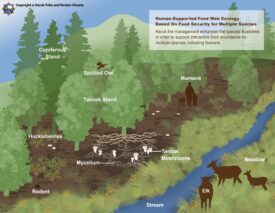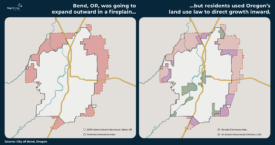Today, it’s almost impossible to imagine the Pike Place Market without stall after stall of flowers: tulips in spring, dahlias in summer, dried bouquets in winter. But three decades ago, that future was not assured. It drew only a few dozen farmers selling produce there on busy Saturdays.
Around that time, Seattle had become a destination for a growing number of Hmong refugees, who had provided intelligence and combat support to the US during the Vietnam War. Many had been farmers in the highlands of Southeast Asia. After American troops pulled out, Communist reprisals forced a mass exodus of Hmong families to refugee camps.
Those who were eventually resettled here needed to earn a living. And Steve Evans, who took a job as the Pike Place Market’s farm specialist in 1981, remembers the opportunity that presented:
We saw the Hmong farmers as being the next generation that would come to Pike Place and keep the farmer at the market, and that turned out to be the case.
Today, nearly 40 percent of the farm vendors who sell from the Pike Place Market’s busy tables are of Hmong descent. But the transformation didn’t happen organically. It took money, land, and sustained efforts to help those original families learn basic farm skills like operating mechanized farm equipment and making change with American money.
Today, agricultural experts are looking to other minority and immigrant groups—from Latino farmworkers to new refugee populations—to fill a looming void as aging farmers who now grow our food begin to retire in massive numbers. They’re frequently mentioned in conversations about the new “next generation” of farmers.
But establishing a profitable farm isn’t easy for someone who’s not comfortable in English or has never opened a bank account. New incubators around the region—including several aimed at minority farmers—are helping aspiring growers learn sustainable farming practices, find a niche and build the customer base they’ll need to succeed on their own. Most are too new to predict how successful they’ll be.
But the Hmong farming experience in this country, now 30 years in the making, offers three important lessons:
- It is possible for an immigrant population to find a successful niche in the Puget Sound farming ecosystem.
- It won’t happen without a lot of initial support.
- The challenges never go away.
The Indochinese Farm Project
The support that the Hmong received ultimately helped make the Pike Place Market a more vibrant place. But it required substantial investment. From 1982 to 1989, the Indochinese Farm Project helped train newly resettled Hmong refugees in everything from modern agricultural techniques to learning English. The nonprofit, which was heavily dependent on grants, operated an incubator on an 22-acre parcel of county-owned parkland in Woodinville.
Evans, who was in charge of working with market farmers at the time, remembers the extensive skill building that went on. They trained refugees on how to keep tractors running and plant in rows. The Hmong had to learn basic English vocabulary, how to make change, how to price items, and what American consumers demanded in terms of quality. As Evans says:
One of the big things we had to do was to teach them what our money looked like, the difference between a $1 and a $5, the difference between a dime and a quarter. We had to teach them some rudimentary English phrases. We did role playing exercises where we were the buyer and they were the vendor. We did a lot of that.
He helped the Hmong farmers get established at the Pike Place Market, but other markets didn’t cut them any breaks. They had an account to sell to Safeway for a number of years, until the chain decided that all of its fresh products had to be refrigerated post-harvest. The Hmong didn’t have access to refrigeration or coolers and lost that account.
The farmland that they could afford to rent, both on and off the incubator, often lacked water rights. And this marginal land proved to be a blessing and a curse. One of the least thirsty crops they could grow was flowers.
Bee Cha, whose family immigrated from Laos and who now works as the immigrant coordinator for WSU’s small farms team, said flowers turned out to be easy to grow and required relatively little maintenance. The Hmong also stumbled onto an untapped market niche, with lush bouquets that appealed to tourists and downtown office workers alike. But it wasn’t an obvious fit, Cha said:
Flowers didn’t have anything to do with the Hmong history. We didn’t farm flowers, we didn’t grow flowers, now they grow them because they can sell them. They’ve been able to adapt to growing things that they don’t like to grow or don’t eat. They don’t eat beets. They don’t eat flowers.
In the late 1980s, funding for the Indochinese Farm Project became more scarce at the same time that some Hmong families were looking for acreage elsewhere. Many relocated from South King County to Carnation, which was closer to the area’s remaining farmland and still offered affordable housing at the time. More experienced growers took on the role of training family members or newly arrived immigrants. The nonprofit incubator eventually disbanded, though some growers banded together in a new cooperative.
The training and support that the Indochinese Farm Project provided to the fledging Hmong farmers is no different than what you find today at new incubators such as Viva Farms or Seattle Tilth’s Farm Works, said Evans, who now works as a farm specialist for King County. The challenges that face Spanish-speaking farmworkers or recently arrived African immigrants who want to run their own farming businesses are essentially the same, he said:
You can take anything you’ve learned from those efforts and, basically, there’s very little difference. We just did it 20 or 25 years earlier.
Today’s challenges
The goal of any incubator is to eventually spin off businesses that can stand on their own. By many definitions, the Hmong farming story is a successful one. Nearly 100 families have found land to rent, and are growing and selling farmed products. But the challenges never go away, said Cha:
Once they’re on their own, they have the same problems. It doesn’t matter who the farmers are. Once you move off the incubator you will be facing the same issues.
Here are some of the big ones, according to Cha and Evans, for the Hmong and the newer generations of immigrant farmers:
1. Access to affordable, decent land
The Hmong are still, in large part, a landless population. The majority of farmers rent their land. It often lacks a reliable water source, unless it’s flooding. For many families, buying farmland in the Puget Sound region is prohibitively expensive. That means they have to deal with the whims of the people who own property, and may have no guarantee that they can stay there indefinitely. That bedrock lack of security makes it difficult to think longterm or see much benefit in investing to improve their farm operations.
2. Marketing and business savvy
Few Hmong farmers have business plans. They tend to see someone succeeding at selling something and follow suit. But if a particular market already has one or two Hmong vendors selling flowers and vegetables, they usually don’t want any more. So, as a group, Hmong farmers wind up competing with one another.
3. Finding and maintaining a niche
The reason that Hmong farmers were able to survive is because they found a viable cash crop: flowers. But that success can be hard to replicate in today’s crowded marketplace. Newer immigrant farmers face competition from existing farm businesses and other aspiring farmers, particularly if all they’re growing is beets and carrots and other vegetables that you can find at a half dozen other booths at the farmers market.
So we’re faced with a vexing catch-22. We know we’re going to need more farmers when the ones in business today retire. It only seems fair that the people who already work hard at growing our food should have the opportunity to start new farms, alongside young, unencumbered hipsters and white collar job refugees buying up farmland with stock options or nest eggs. But it can be tough for immigrants and non-native English speakers to compete with experienced businesspeople or new growers who don’t have to bridge vast cultural gaps just to talk to customers or cold call a restaurant.
The Hmong experience shows that it’s possible to support minority and socially disadvantaged farmers, but it has to be a priority. So the question for people working in food and farm circles today—and really anyone who eats—is this: How much does it matter to you?










